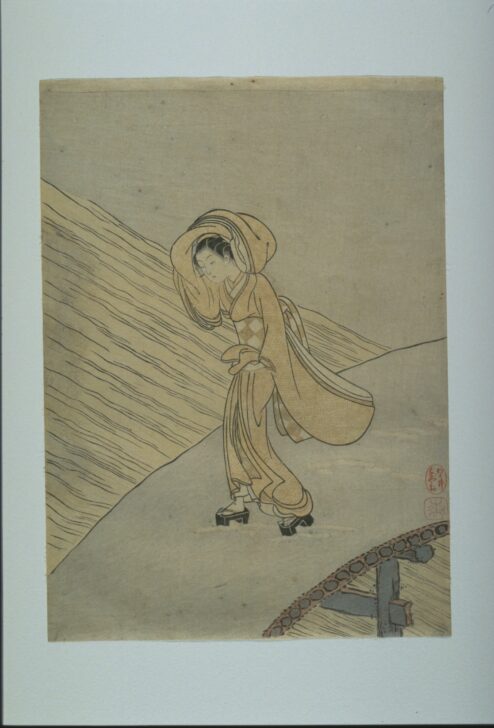Young Girl Crossing a Bridge on a Windy Day; Calendar Print: Parody of “Crossing at the Sano Ford” (Hashi wo wataru musume: Egoyomi, Mitate Sano no watari)
Suzuki Harunobu

Description
Full-color printing emerged in Japan only in 1765, when a wealthy group of patrons in Edo commissioned Suzuki Harunobu to design a limited edition of deluxe prints. Intended as New Year’s greetings, these privately published prints contained "hidden" clues to the calendar for the coming year.
The calendar prints were so popular that a second edition was printed for commercial distribution. This print comes from the later edition, which retains the technical innovations of the first: cherry-wood blocks have replaced softer catalpa wood; a thicker, hard-surfaced paper retains the impression of blind printing; and up to ten blocks are used for a new palette of vegetable colors. Full-color printing became the norm from this point forward, and such prints are known as nishiki e, or "brocade prints."
Harunobu became famous for his renderings of willowy young girls, vulnerable if not quite fragile. Like the Kyoto artist Nishikawa Sukenobu (whose designs he often plagiarized), Harunobu drew his subjects from everyday life rather than from the theatre and pleasure quarters. Harunobu was also fond of visual puns in his work. Here the pose of the girl on the bridge is taken directly from a well-known type illustrating a classical poem. In the model, a male courtier is shown fording a river on horseback; to shield himself from the falling snow, he tosses one arm over his head.
M. Graybill
"Courtesans, Cross-Dressers, and the Girl Next Door Images of the Feminine in Japanese Popular Prints"
3/9 - 9/1/02
Subject Matter:
The image is based on a poem by Fujiwara Teika called "sano no watari" which describes a traveler (meant to be Fujiwara) in unrelenting snowfall. In this image, the subject is replaced by a young girl. When someone is replaced in an image, it is called a "mitate".
This is also an "Egoyomi" which is a picture calendar. This the one of 1765.
Suzuki Harunobu was known for his colorful works which we can see here in the flashes of bright yellows.
(https://dl.ndl.go.jp/view/download/digidepo_11481280_po_NDL-Newsletter219_21903.pdf?contentNo=1&alternativeNo=)
Physical Description:
A girl wearing a yellow kimono and black sandals, one arm over her head as she crosses a bridge over a body of water. There are two red seals organized vertically on her right.
Usage Rights:
If you are interested in using an image for a publication, please visit https://umma.umich.edu/request-image/ for more information and to fill out the online Image Rights and Reproductions Request Form.